Washington County Barn Survey: A volunteer effort is currently underway to survey and document the early barns of Washington County, New York. For more information about the survey, see the PDF below.
Author: barncoalition
Barns as Venues for Weddings and Other Events
Getting Married in a Barn
Historically, barns were occasionally used to hold weddings and other gatherings. If you are interested in continuing this tradition, while simultaneously supporting historic barns, below is a list of venues in New York State where it is possible to hold your event within or adjacent to a barn. If you know of other event spaces with barns in New York, please let us know, and we will add you to our list.
Barns in the News
Barn Tour sponsored by Howland Stone Store
15th of August (Sunday) from 1-4 pm.
Seven locations, some of them have more than one barn to look at
For more information go to www.howlandstonestore.org
This will be a must see tour for any barn connoisseur.
Barn Surveys: Tompkins County Historic Barns Driving Tour
This driving tour was prepared by Historic Ithaca and the New York State Barn Coalition in association with the New York State Barn Coalition’s Annual Conference of 2008. Please use the map and barn histories to appreciate these historic properties from the road. As always, do not trespass on private property, and please drive carefully!
Barn Types: Potato Barns
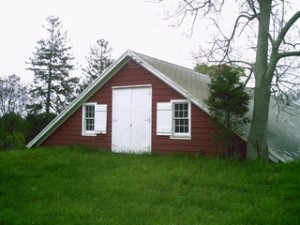 Potatoes originated in South America. They were subsequently brought to Spain where potato cultivation became common by the late 16th century. From Spain, the potato was disseminated to other parts of Europe, and was introduced to North America through European settlement.
Potatoes originated in South America. They were subsequently brought to Spain where potato cultivation became common by the late 16th century. From Spain, the potato was disseminated to other parts of Europe, and was introduced to North America through European settlement.
Potatoes became a staple in North American farming in the early 18th century, but it was not until the early 20th century that American farmers began to cultivate them on a large scale. In the northeast, potato farming in the early 20th century occurred on a large scale in northern Maine, Connecticut, Rhode Island, and New Jersey, as well as New York. By mid-century, potatoes were Long Island’s most important crop (Chamberlain 2006). As potato production became increasingly significant both to the region’s and the nation’s food supply, potato barns were constructed on farms specifically for the purpose of storing large quantities of potatoes. Where farmers had formerly stored small potato harvests in root cellars and other small underground structures, the modern potato barn came to the fore at the turn of the century (Visser 1997).
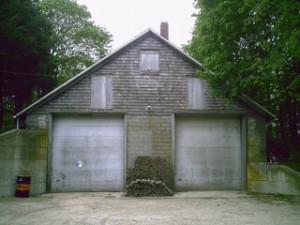 American potato barns constructed from ca. 1900-1950 are typically banked structures, built into a berm or hillside. The lower portions of most potato barns are usually built of concrete, while the upper portions are of wood-frame construction, clad in wood shingles or clapboard. In order to regulate heat and moisture, potato barns are built with few windows (one or two windows with shutters or shields are often placed at the gable end) and the barns have vents along the roof or at the gable end. The side walls of the barns, where exposed, are commonly reinforced by buttresses, and the barns often have a small brick side chimney. They are typically located at the side of roadways, for easy vehicular access, usually adjacent to the field on which the potatoes were grown.
American potato barns constructed from ca. 1900-1950 are typically banked structures, built into a berm or hillside. The lower portions of most potato barns are usually built of concrete, while the upper portions are of wood-frame construction, clad in wood shingles or clapboard. In order to regulate heat and moisture, potato barns are built with few windows (one or two windows with shutters or shields are often placed at the gable end) and the barns have vents along the roof or at the gable end. The side walls of the barns, where exposed, are commonly reinforced by buttresses, and the barns often have a small brick side chimney. They are typically located at the side of roadways, for easy vehicular access, usually adjacent to the field on which the potatoes were grown.
While often located on the same parcel as a farmhouse, potato barns were sometimes constructed on separate parcels a short distance away. Because large-scale potato farming was generally a 20th century phenomenon, advances in vehicular transport enabled the farmer to engage in agricultural activities slightly further from home. While large-scale potato farming in Eastern Long Island persists today, there has been a dramatic shift in recent decades away from an agricultural economy, and towards a service economy.
Potato barns are an iconic building type in Long Island and other parts of New York State where potato cultivation has figured prominently. While many of these structures date to the 20th century and are constructed of materials such as concrete block or poured concrete, potato barns are an aesthetically distinct and historically important part of New York State’s built heritage and agricultural history.
Posted by Molly McDonald, a New York State Barn Coalition Board Member
Photographs by Robert Caravella
References
Chamberlain, Wendy, 2006. True East: Farming Ancestral Lands on Long Island’s East End. Southampton, New York: Peconic Land Trust.
Visser, Thomas Durant, 1997. Field Guide to New England Barns and Farm Buildings. Hanover and London: University Press of New England.
Barn Stories: “The Three Barns” in Lansing
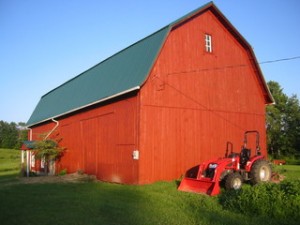 I grew up in Lansing, New York and for a significant portion of my life I have been an observer of the conversion of fields and open space to housing lots and subdivisions. I have also been a quiet chronicler of the loss of barns and outbuildings. I am heartened that a few barns from my childhood remain.
I grew up in Lansing, New York and for a significant portion of my life I have been an observer of the conversion of fields and open space to housing lots and subdivisions. I have also been a quiet chronicler of the loss of barns and outbuildings. I am heartened that a few barns from my childhood remain.
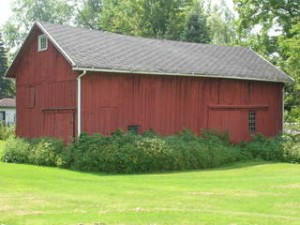 They are near the corner of where the Lansing, Groton and Dryden Townships intersect. Two are on the Howe farmstead, one being the dairy/hay barn (left) and the other the horse barn (below).
They are near the corner of where the Lansing, Groton and Dryden Townships intersect. Two are on the Howe farmstead, one being the dairy/hay barn (left) and the other the horse barn (below).
Both of these are still in the family. The horse barn, owned by my cousin, is being used primarily for storage. The dairy barn, owned by my brother, is now serving multiple uses: as a family gathering spot, to store hay, as a garage to work on tractors, as a playground, as a place for a new rock band to practice. The third barn was on the next farm over and was owned by an aunt and uncle. I have recently purchased the barn and my plans for its use are still developing.
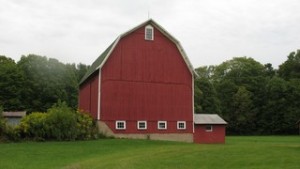 I now consider these simply “the three barns.” They are basically within sight of one another. They now tell a different and story from 100 or even 25 years ago. They appeal to me on several levels: historically, architecturally, and as a student of sociology and community and economic development.
I now consider these simply “the three barns.” They are basically within sight of one another. They now tell a different and story from 100 or even 25 years ago. They appeal to me on several levels: historically, architecturally, and as a student of sociology and community and economic development.
Posted by Rod Howe, a NYS Barn Coalition Board member
Barn Surveys: Delaware County Barn Survey Book
This Barn Survey Project was completed in Delaware County in 2000.